Pelayo was a French-built Battleship, first modern one in service with the Armada. A fitting subject for the 12 October, Spanish National Day and Feria. Pelayo was also the most robust proposition of the whole Spanish Navy when the 1898 broke out. She stayed to defend the homeland, together with several rebuilt ironclads, never engaging the US fleet. She was still in service in WWI, and was a gunnery ship in 1920-21 until decommission. In between, the Armada indeed completed three Dreadnoughts (Espana class).
Development & Context
The “solitario” or “lonely” as nickamed was indeed, a revolution for Spain, which between economical decline and political turmoil experienced difficult decades post-1870. By that time, the homeland Navy counted mainly on five more or less modernized ironclads: Numancia, Vitoria, Zaragosa, Sagunto and Mendez Nunez. This was a potent force, but in 1880, woefully obsolete and in need of compehensive rebuilt. There was no extent of modernization however than can replace the contruction of brand new, state of the art battleships. The general staff of the Armada agreed on this fact and under the leadership of Admiral Antequera, a proposal was made of a large naval shipbuilding program with six modern, ocean-going battleships. For this, it was decided to launch a request for proposal to various Yards out of Spain, chief of Which were Britain and France, but also Germany and Italy. However the original program was cut down to just a single one.
The French proposal, from La Seyne, Toulon, soon attracted interest due to the French Jeune Ecole concepts, which had particular views for battleships, between their single-guns of heavier caliber and longer range, and typical tumblehome supposed to improved seakeeping.
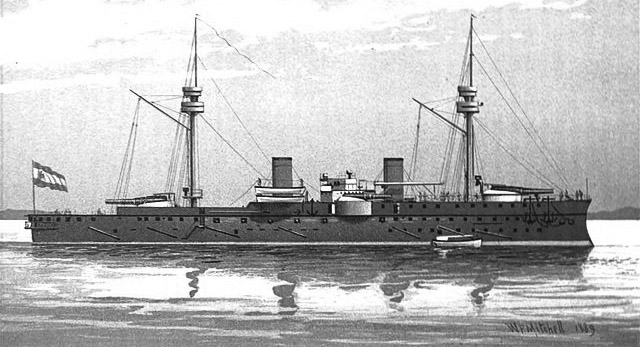
Brasseys 1889 engraving
The retained proposal in 1884 came from La Seyne, engineer Amable Lagane, based on the French Marceau class. It was just slightly longer, shallower in draft to allow her to use the Suez Canal. There was an option for her to carry a sail rig for 372 m² to be able to defend the Spanish Empire, but the design was changed again to military masts typical of French construction. The armour was made of Schneider Le Creusot steel with a full lenght belt going 1.5m below the waterline, 0.6m above and extensive compartmentation below the armored deck and 13 full transverse bulkheads, with additional rooms filled with cork, an idea of engineer Emile Bertin. What also won for this yard was the use of massive Canet guns, a very powerful 12.6 in (32 cm) 38 cal. which had little competition at that time. Typical of French designs, Pelayo also had two broadside turrets with 11 inch guns (28 cm) for closer range and with greater rate of fire, and a sizeable secondary battery. However these guns were not to be forged in France, but in Spain, by Hontoria, coming with a technology transfer which sealed the deal.
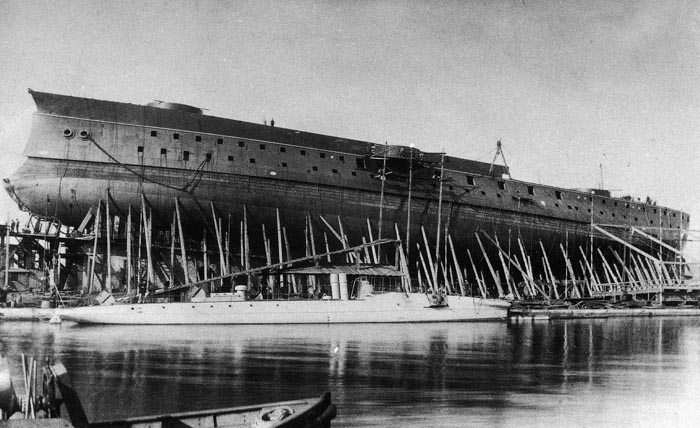
Pelayo’s hull ready for launch at La Seyne. A French TB was moved close to give the scale. Note the caracteristic clipper bow above the curved ram bow, unique to this battleship.
The new battleship would become the only capital ship of the 19th century, at least until the conversion into coastal battleships of the armored frigates Numancia and Vitoria, decommissioned as the Epana-class battleships arrived from 1913. “solitario” was indeed the lone modern Spanish Battleship, as finances were sufficient to modernize two ironclads, but not to purchase a a sister-ship to Pelayo. She became de facto flagship for many years, basically from 1888 to 1913, so for a quarter of a century.
Design
Hull and general arrangements
Basically she was an elnlarged Marceau class battleship, a barbette ship (with open barbettes, armored rotating platforms) on all four turrets, in a typical lozenge pattern. Otherwise, her hull was typically French, with a ram bow, pointy stern with a walkway, and considerable tumblehome on her greatest beam. She was pear-shape. The oiriginal engineering idea was to decrese artifcicially topweight, to improve seakeeping, stability and procure a more preductable, gentle motion for the main battery. What also helped stability was her much reduced superstructures, in full constrast to some French ships like the Hoche. In general, she had an harmonious profile, with a long forecastle going aft of the second funnel, and continued by bulwarks until her aft mast.
She had two funnels mounted amidship, and two masts well spaced fore and aft. Unlike many contemporary French designs of the time, these military masts were relatively slender, yet tall, carrying two tops, one with Antit-TB light guns and one above with spotting equipments. A lower platfor projector was installed close to the base. The two tops were accessed by goold old fashioned rope ladders. Both also had service booms. She carried a crew of 520 officers and enlisted and two pinnaces, two yawls, a cutter and a steamboat picket ship plus four unidentified axtra ships). The two yawls were suspended over the tumblehome under davits amidship, while boats were located fore and aft of the superstrucuture and others four under davits, amidships and aft.
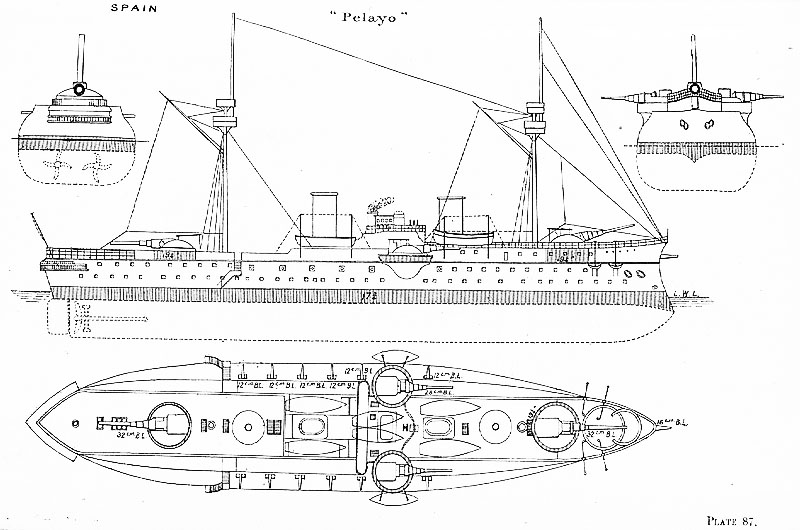
The hull measured 334 ft 8 in (102.01 m) overall, to the tip of the ram, significatly larger than the Marceau. The Beam was 66 ft 3 in (20.19 m) amidship, and draft 24 ft 9 in (7.54 m) max, for a total displacement of 9,745 tons. She was unusual as having her larger bridge superstrcture mounted in between funnel, with a conning tower in the main bridge and supporting a small walkway. The rest of the intermediate bridge supported a small command bridge with wooden panelling, and on top were platforms for four light QF guns. Her total cost, wihout armor nor armament has been 22 million pesetas in 1888.
Armour Scheme
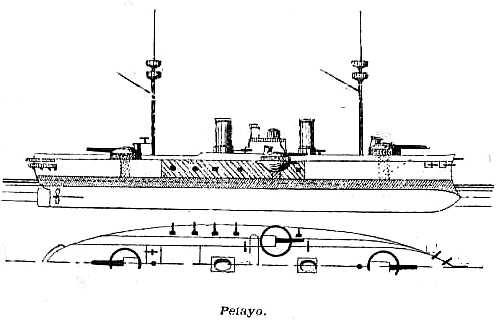
It was all made of Creusot steel.
-Belt: 17.75–11.75 inches (451–298 millimetres)
-Barbettes: 15.75–11.75 inches (400–298 millimetres)
-Shields: 3.125 inches (79.4 mm)
-Conning tower: 6.125 inches (155.6 mm)
-Main armored Deck: 2.75–2 inches (70–51 millimetres)
-Midships battery unarmored (as built) 3 inches (76 mm)
Harvey armor was applied after the 1897–1898 reconstruction.
Powerplant
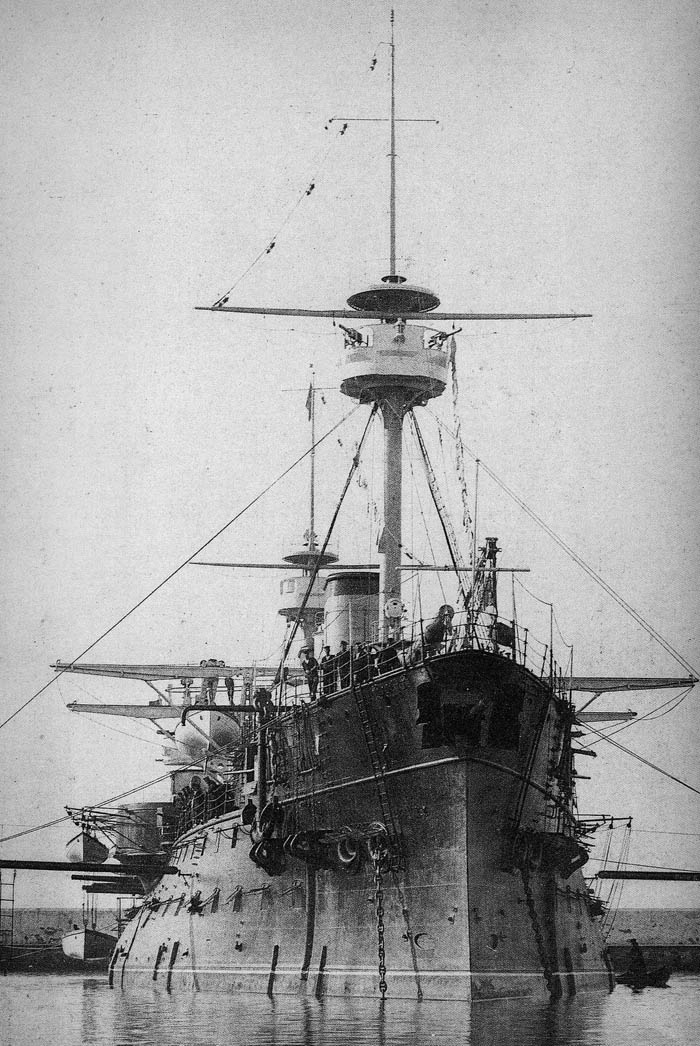
Pelayo’s prow (src vidamaritima.com as the ones below)
She had two shaft propellers, connected to two, 2-cyclinder vertical compound engines, fed in turn by 12 return-tube boilers for an installed power of 9,600 ihp (8,000 ihp normal draft trials). However these Niclausse boilers working at 85 pound/sq. foot left much to be desired. During a refit 1897–1898 they were replaced by 16 Normand-class boilers. This procured 16.7 knots in forced draft as built in 1888 and after refit, 16.2 knots on natural draft in trials. This was later improved. She also carried in normal condition some 800 tons of coal, later extended to 1,000. Range was about 3,000 nautical miles at 10 knots.
To spare coal on long-range mission it was also decided she would carry an imposing sailing plan of 4,000 square feet (1,219 square meters), with schooner sails on the two masts, intermediary foclsails, spankers and intermediate ones, and three jibs from the mainmasts to the prow. It was quickly removed and in fact no photo shows her with it.
Armament
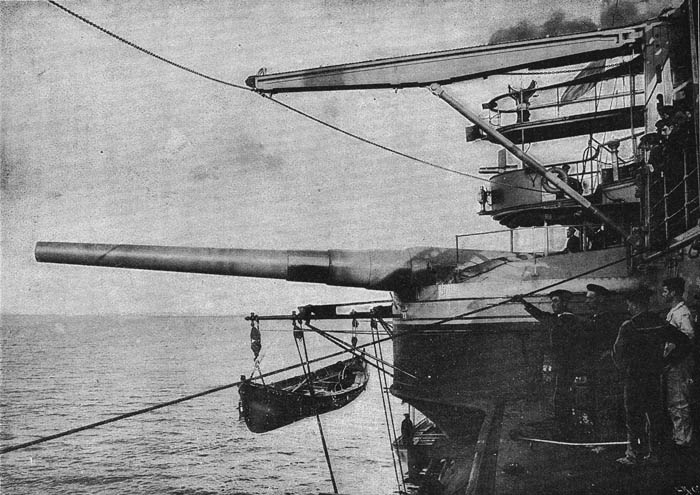
Broadside 28cm Canet gun
Her main guns could be loaded in any position, and consisted of two Gonzalez Hontoria-built 32-centimetre (12.6 in) Canet guns mounted fore and aft on the centerline and two Gonzalez Hontoria 28-centimetre (11.0 in) guns, also in barbettes, with one mounted on either beam.
Main 320 mm (12.6 in) Canet/Hontoria
Canet was contracted to to build 28 cm (11″) and 34 cm (13.4″) guns originally, These were export only and called 32 cm/35 (12.6″) Model 1880 in Spain. Others of similar types were also built for Japan. They were replaced by their equivalent made by Hontoria after her first refit. They were fitted on open barbette with some protection overhead, and could depress -5 and elevate +15 degrees max.
Projectile: AP (cast iron bomb) – 879.6 lbs. (400 kg)
Charge: 485 lbs. (220 kg) of prismatic powder
Velocity: 2,034 fps (620 mps)
Max Range: at 15°, 12,030 yards (11,000 m)
Penetration: At 3,230 yards (2,950 m) vs 13.9 in (353 mm) Krupp armor
Rate of fire: 0.2 rounds per minute
More
Main 280 mm (11 in) Hontoria
Called the Cañón Hontoria 280/35, mod.1883, these were manufactured in several Spanish workshops for the Infanta María Teresa class armored cruisers, Carlos V and battleship Pelayo.
They were designed by naval officer José González Hontoria in 1883 as an improvement on the French Canet 274 mm. It was performed at the Trubia state arms factory (Asturias) and the very first guns of that size to be built in Spain. They were both mounted on broadside barbettes. Tubes were often ordered abroad, in France and Britain for the cruisers.
Barrel Length: 9787mm
Projectile: AP shell 266 kg, HE shell: 315 kg
Rate of fire: 1 spm
Max range: 9,250 meters
Velocity: 620m/s
Secondary 120 mm/35 (4.7 in)
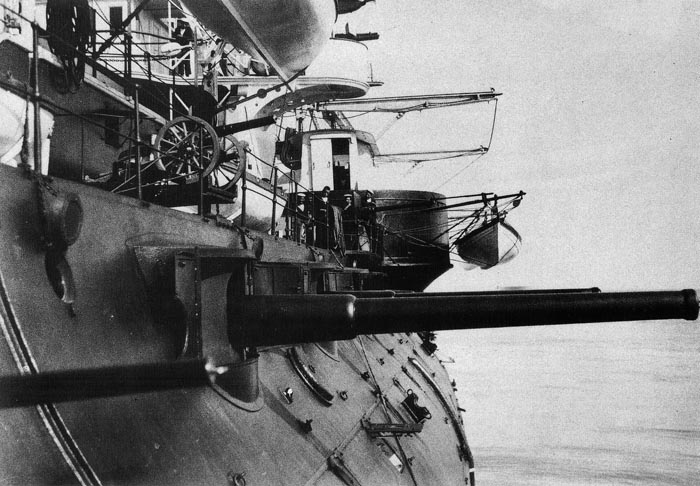
Secondary guns on Pelayo. Note the field gun on deck above.
The Gonzalez Hontoria de 12 cm mod 1883 were designed as an improved local variant of the Canet guns. They were procured to the three Isla de Luzon class, Reina Regente class, the TB gunboats Maria de Molina class and of the Temerario class and the Velasco-class cruisers. On her side, Pelayo a twelve casemated 12 cm guns in single mounts amidships.
Barrel weight: 2.6 t (2.9 short tons)
Barrel Length: 4.2 m (13 ft 9 in)
Total mount height: 2.5 m (8 ft 2 in)
Charge: Separate loading, 13 kg (29 lb) smokeless powder bagged charge
Shell: weight 24 kg (53 lb)
Breech: Interrupted screw
Muzzle velocity: 612 m/s (2,010 ft/s)
Maximum firing range: 10 km (6.2 mi) at +25°
They were to be replaced by nine 140 mm/
Light anti-TB armament
Three (later Five) Hotchkiss 57 mm L/42 (3 pdr)
Thirteen 37 mm Hotchkiss L/20 five-tubes QF guns (2 pdr)
Four Vickers 7.65 mm (0.3 in) Machine Guns, can be dismounted for a landing party.
They were kept pretty much until her deactivation, post-WWI.
Torpedo Tubes
Originally, Pelayo was equipped with seven 356 mm (14 in) torpedo tubes: Two broadside underwater, one at the bow, one at the stern. Probably of the Whitehead 1882 type, by default of other informations. In 1904, these tubes were reduced to three.
Major Reconstruction
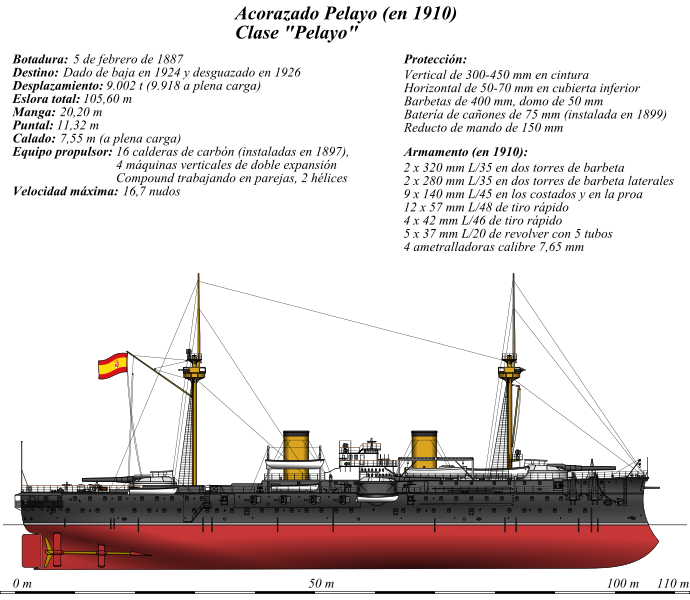
Pelayo was reconstructed at La Seyne in 1897–1898, receiving armor for her midships battery and having her 16-and-12-centimetre (6.30 and 4.72 in) guns replaced by 14-centimetre (5.51 in) pieces, one mounted as a bow chaser and the rest on the broadside. However, the installation of these new guns was disrupted and delayed when she was rushed back into service after the Spanish–American War began. During a major refit in 1910, her torpedo tubes were removed.
Read More/Src
Aguilera A., “Pelayo,” Buques de la Armada Espanola. (Madrid, 1969) p. 13-16.
“Spanish Battleship PELAYO,” Warship International. (1970. – # 2) p. 183-184.
Mitiuckov N.V., “Ispanskiy Bronenosets PELAYO,” Krasniy Officer. (1996. #1) S.2-6.
“PELAYO” Voennie Floti i Morskaya Spravochnaya Knizhka na 1897 god.- SPb:
Typography by Edward Goppe, 1897. – S. 401-404.
Wilson H.W., Downfall the Spain. (London: Sampson Low, Maston & Co, 1900). p. 454
Cervera y Topete, Pascual. ONI War Notes No. VII on The Spanish–American War. Washington Government Printing Office, 1899.
Gibbons, Tony. The Complete Encyclopedia of Battleships and Battlecruisers, Capital Ships From 1860 to the Present Day. Salamander Books
Gray, Randal, Ed. Conway’s All The World’s Fighting Ships 1860-1905, 1906–1921. NIP
Nofi, Albert A. The Spanish–American War, 1898. Conshohocken, Combined Books
Pastor y Fernandez de Checa, M. (1977). “The Spanish Ironclads Numancia, Vitoria and Pelayo, Pt. III”.
Warship International Staff (2015). “International Fleet Review at the Opening of the Kiel Canal, 20 June 1895”. Warship International.
Links
On spanamwar.com
On todoavante.es/
Noted in dispatches abc.es/abc-madrid
web.archive.org pelayo and pascual-cervera
The battleship that “terrorized” the US: Pelayo (archive)
es.wikipedia.org
Videos
Battleships of spain
The spanish Navy in 1898
Model kits
The arno 1/700 kit
Therse is also an old glory 1/600, annother 1:700 by Jadar, but that’s about it. And the book El acorazado “Pelayo”, Alejandro Anca – La Maquina y la Historia: Perfiles Navales Nr. 1
General query on scalemates
Pelayo in service
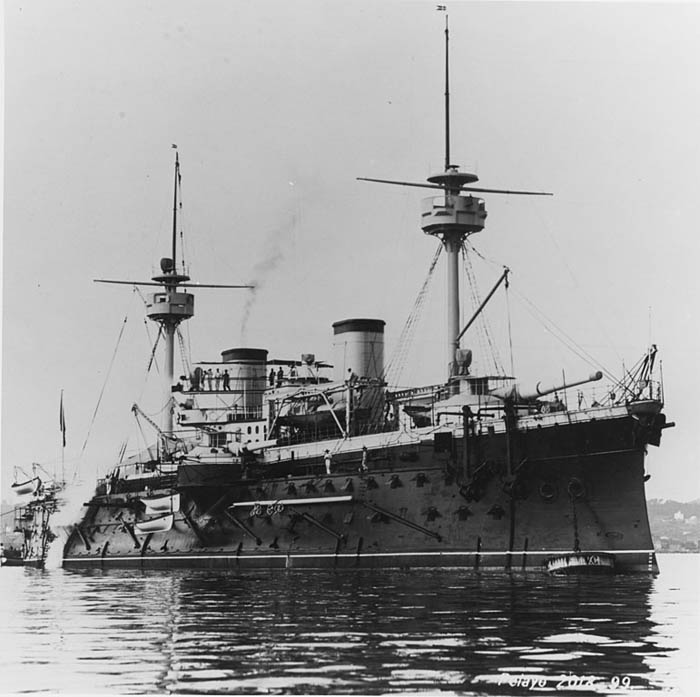
Pelayo in 1889
She was launched in Toulon on February 5, 1887 in a ceremony held by the Minister of the Navy, Admiral Rafael Rodríguez de Arias, Bishop of Toulon and other personalities. The old sailing Frigate Blanca was also present at sea to fire a gun salute. On September 8, 1888, Pelayo was handed over to the Arrmada in Toulon, with the presence of the Instruction Squadron under orders of Rear Admiral Don José de Carranza y Echevarría (Numancia, Castilla, Isla de Luzón).
Pelayo was commissioned in September 1888 after three years of construction, which was short to French standards of the time. She started her voyage to Spain and started training. Search of her records. Don Pascual Cervera supervised her construction and was first commander, raising his battle flag donated by Asturias. In January 1889 after trials, she returned to Toulon alterations and improvements and was back in Spain in September with the Instruction Squadron.
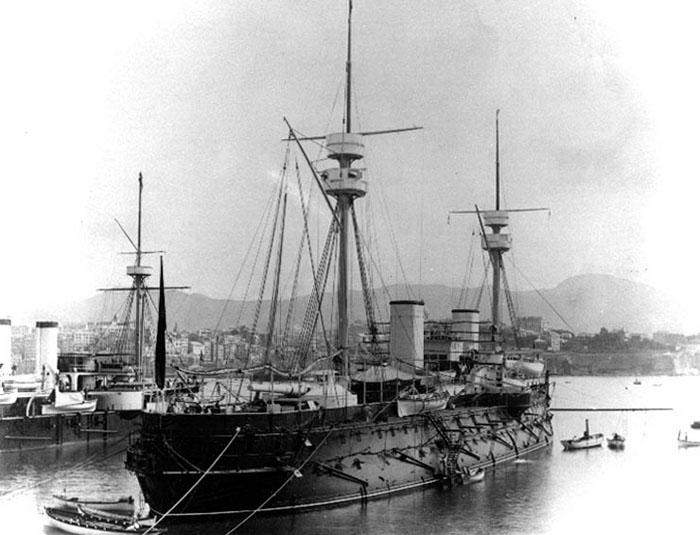
Pelayo in October 1892
As the first modern battleship of Spain, she was present in many event and port to show the flag and became quite popular. Still, the absence of a sister ship has the Naval staff seaching for a way to use “solitario”. In September 1889 the situation degraded in Morocco with several merchant ships seized and attacked, and the Training Squadron in Cádiz sailed for Alhucemas on the 23th under Rear Admiral Carranza. Outside Pelayo (flagship), still without her main artillery, Numancia and Castilla went with her. They relieved the frigate Gerona and cruiser Isla de Luzón, and received reinforcement from Isla de Cuba and Navarra from Tangier, to Al Hoceima with emissaries from the Sultan of Morocco. Rear Admiral Carranza made Gerona his flagship as Pelayo lacked her main armament.
By December 1889 she weathered a strong storm in the the Gulf of León, and stayed off Marseille before being able to proceed back to Mahón. She was summarily repairs and sailed in April 1890 to Toulon to have at last her main artillery installed. She hosted French President Carnot on April 19. She departed for her first Mediterranean tour, stopping at Piraeus in the spring of 1891 Reina Regente and Island of Luzon and torpeod boat squadron commanded by Admiral Butler. She hosted the Greek King and his family. In August 1 she was visited in Ferrol by the Minister of the Navy, José María de Beránguer. Later she was protecting the Royal Family in San Sebastián’s summer resort, being visited by the Regent Queen before heading back to Ferrol.
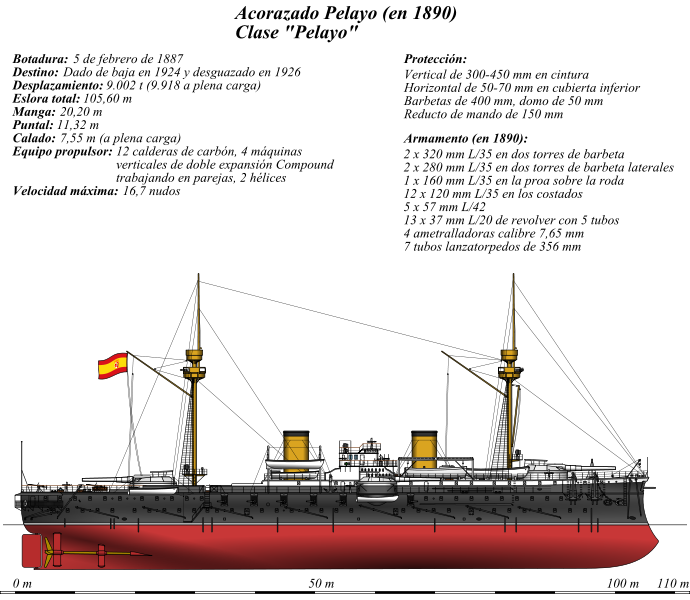
She was in Genoa for the fourth centenary of the discovery of America, arriving on September 4, 1892 under command of Rear Admiral Don Zoilo Sánchez Ocaña (Pelayo, Alfonso XII, Reina Regente, Vitoria<, Temerario). She embarked the Royal Family in Cádiz on October 10 and escorted the Conde de Venadito to Huelva with the cruisers Isla de Cuba and Isla de Luzón, Torpedo gunboats Temerario and Cuervo. They took positon in parallel lines alongside the cruiser. After the cruise she headed back to Cádiz.
At the end of August 1893, ships gathered in Cartagena for torpedo exercizes, off Santa Pola. Pelayo, took part with the cruisers Alfonso XII, Reina Regente and Isla de Cuba plus the TBs Barceló, Rigel, Habana from Cádiz. In October 1893, she took part in an exercize of the Instruction Squadron (Rear Admiral Don Zoilo Sánchez Ocaña) from Cartagena to Santa Pola, with a battle scenario off Alicante. Pelayo teamed with Reina Mercedes and Isla de Cuba, the TBs Barceló, Rayo and Rigel. She also covered a mock landing and the exercize ended on October, 22.
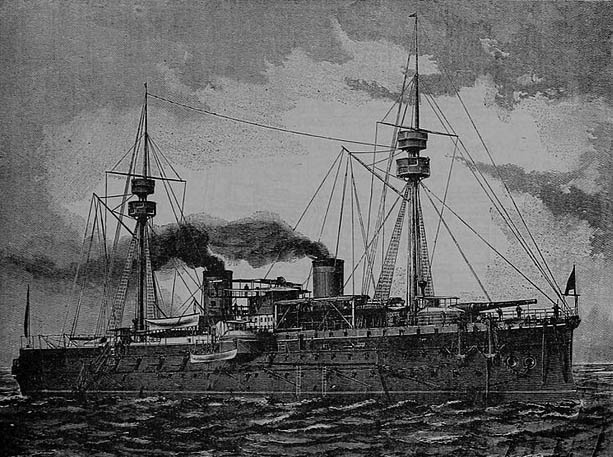
Pelayo in London Engineering engraving
In September 1893, the Rif War erupted near Melilla and the Training Squadron was ordered to North Africa under Rear Admiral (from November 1893) Díaz Moreu. They were gathered in Melilla at the end of November and covered a landong of troops commanded by General Martínez Campos. In 1895, Pelayo represented Spain at the opening of the Kiel Canal, with Infanta María Teresa and Marqués de la Ensenada led by Rear Admiral Martínez Espinosa. She left on July 12, 1895 for Tangier to pressure the Sultan after new incidents in Morocco. The new squadron was formed under Vice Admiral Don Florencio Montojo, with Vizcaya, Alfonso XII and Marqués de la Ensenada. The squadron departed for Algeciras on 17 August.
In 1896, Pelayo went on her training routing with her squadron and by January Rear Admiral Don José Reguera y González Polo took charge, Pelayo teaming with Almirante Oquendo, Infanta María Teresa and Vizcaya. She stopped in Barcelona in June-July and from November was in Toulon (captain Mr. José Ferrandiz y Niño) for an extensive modernization: Boilers, Schneider-Canet 14 cm rapid-fire guns, military tops removed, 7 cm Harvey KC thick plates on the secondary battery. However not only she had her seocndary guns removed, but the new ones not installed when ordered to be rushed out back to Spain.
As this was still ongoing,war broke out with the US and she set sail on April 7, 1898 to avoid internment in Toulon according to neutrality laws. She left without her intended secondary artillery, and joined the Reserve Squadron in Cádiz (Rear Admiral Don Manuel de la Cámara). The latter was soon reorganized into three divisions. A bold plan was planned by Minister Auñón’s for the squadron to operate in the Atlantic (see later), but the government wanted the Reserve Squadron in the Philippines to strengthen the Spanish fleet present in Manila.
The war of 1898
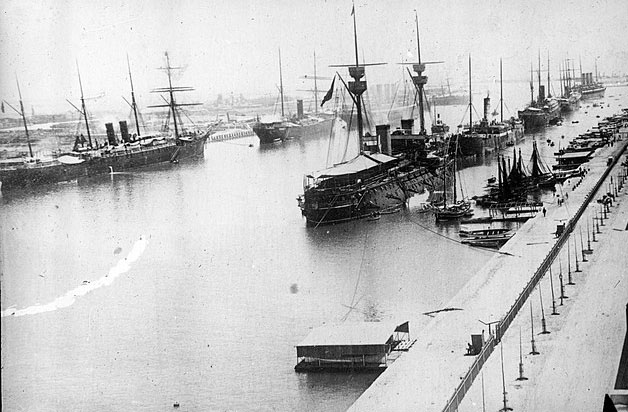
The squadron waiting in the Suez canal, 1898
During the Spanish-American War, the Spanish Admiralty still planned a sortie to alleviate the situation of Admiral Cervera in Cuba. The idea was also to conduct a relaliatory bombardment of the American coast. In fact in the US, a collective psychosis was on the East coast led the US government to order cities to turn off lights at night. For the operation, Admiral Manuel de la Cámara Livermore was chosen, and responsible to prepare the ships. However what he had was not impressive. She ships remaining in Spain were merely the Pelayo, five old coastal ironclads and a few cruisers. The prospect of victory would raise Spanish morale a great deal. In total, he managed to create three naval divisions to confuse the enemy:
-The 1st Division (flag division) saw him on armored cruiser Carlos V, and the torpedo cruisers Meteoro, Patriota and Rapido, plus the gunboat Giralda.
-The 2nd Division under Captain José Ferrándiz y Niño, comprised Pelayo, Vitoria, and the destroyers Audaz, Osado, and Proserpina.
-The 3rd Division under captain José de Barrasa y Fernández de Castro, comprised the auxiliary armed merchant cruisers Buenos Aires, Antonio López and the unprotected masted cruiser Alfonso XII.
Since Pelayo and Vitoria were “short-legged”, the 2nd Division was to lead a diversionary maneuver in the Caribbean Sea, changing course to return home, back to protect the Spanish coast, with the addition of the cruiser Alfonso XIII. Meanwhile, the 1st Division (Carlos V as flagship) was to sail to the Bermuda Islands before starting an attack of the American east coast while heading north towards Halifax to resupply and receive new instructions from the Embassy. After this the squadron was to return to the Caribbean Sea, and notably resupply at the Turks and Caicos Islands.
The 3rd Division was ordered to go to Cabo San Roque in Brazil, and start a commerce raiding campaign against American merchant traffic along the coast, going north as far as the gulf of Mexico.
The project was leaked to British Authorities a some point, notably when preparing the 1st division stop in Halifax. British pressure, which did not wanted an extension of hostilities to the entire Atlantic (and keep trade safe), eventually won over Madrid’s Government.
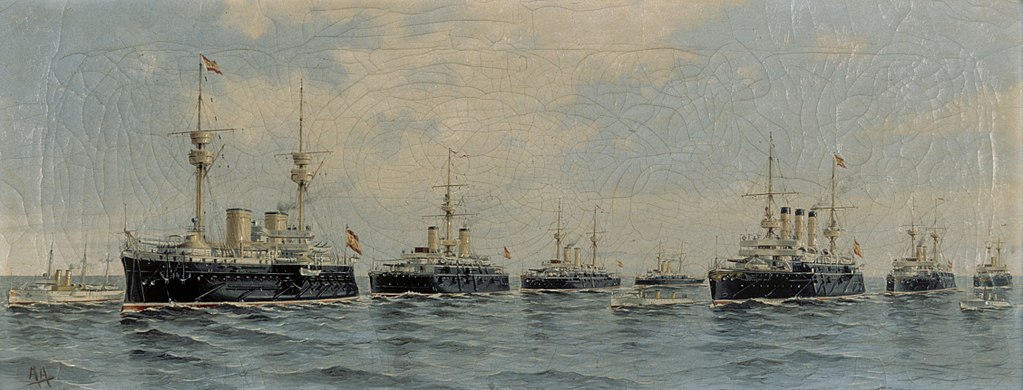
The squadron back in Ferrol, 1898
Pelayo was kept at the head of its own squadron, but prepared for an alternative mission under Admiral Manuel de la Cámara, this time to retake the Philippines. She proceeded to the eastern Mediterranean, then started the crossing of the Suez Canal until she was blocked underway. Indeed, meanwhile, press tycoon William Randolph Hearst gave order one envoys to acquire a local Suez ship, sink it in place to block the passage. The situation remained tense until news arrived of the destruction of Admiral Cervera’s squadron. Under fear of an attack on the Spanish coast, Admiral Cámara’s squadron was ordered back home to defend the coast. Plans for other operations were over and the war ended soon.
Late career: Before and after WWI
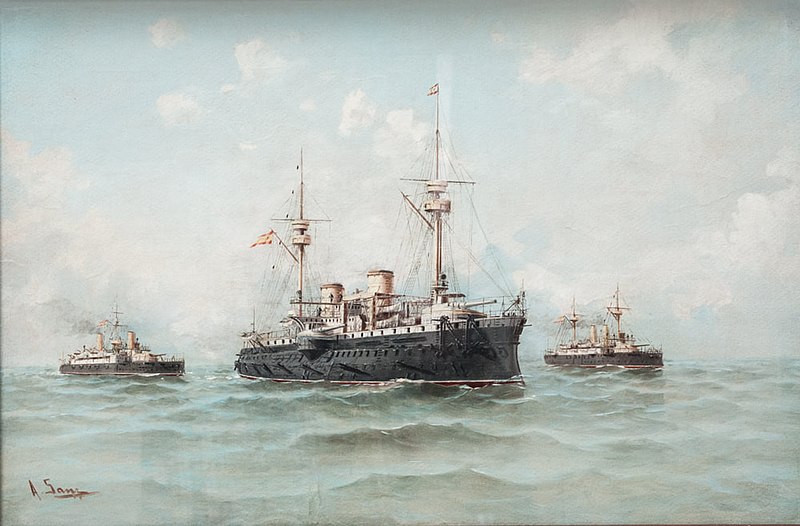
In 1900, a Decree of May 18 by the Ministry of the Navy followed a report about the general condition of the fleet. Technically 25 units were either too old and obsolete or in general poor conditions, and decommissioned to spare maintenance costs and crews. Pelayo was put into scrutiny also, and an examination commission soon raised the need of urgent modifications: Firts came out the need to better protect her main battery, having better boilers, engine and a modernized artillery. At the time she was assimilated to a second-class battleship.
In May 1901, there was a workers’ strike in Barcelona, on which the Government cracked down by sending the army. Many workers were arrested and since jails were overwhelmed, they were sent to be detained in Pelayo at anchor.
Pelayo took part in the 1901 naval review in Toulon and Lisbon, going up the Vigo estuary in 1904. Still, the Navy had a hard time defining an adequate role for Pelayo, being the only one in her class. At least in 1913, the first of the modern Espana class battleships entered service, and Pelayo was now too slow top operate in squadron. She was now retained for training, but managed at least to fire her guns once in anger, when bombarding insurgent positions in Morocco, during the Rif War, on September 1911.
As preconised by the report, she was refitted and updated in 1910 at La Seyne, and notably she saw her torpedo tubes removed. In 1912 she was stranded in Fonduko Bay due to a navigational error and later repaired, but from there, officially tasked to train gunners and navy personal. She spent WWI as such, and until 1921.
Pelayo was eventually decommissioned on August 1, 1924, disarmed, and sold at auction to a Rotterdam company, leaving to be scrapped in April 1926.
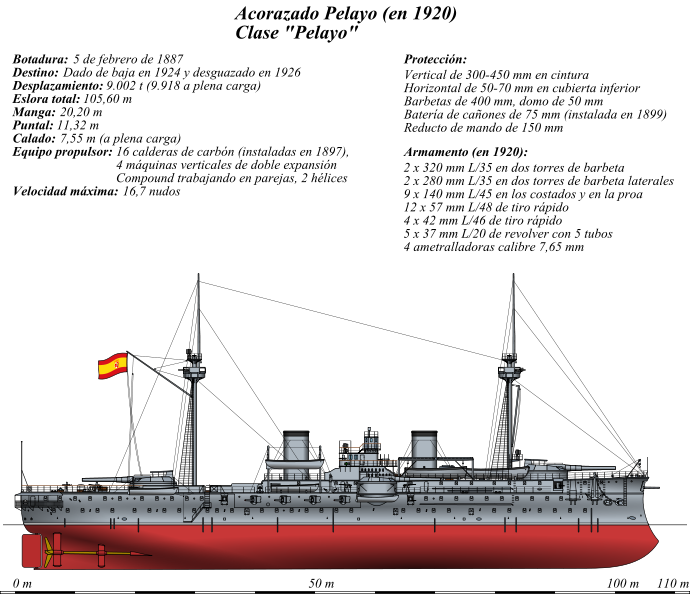

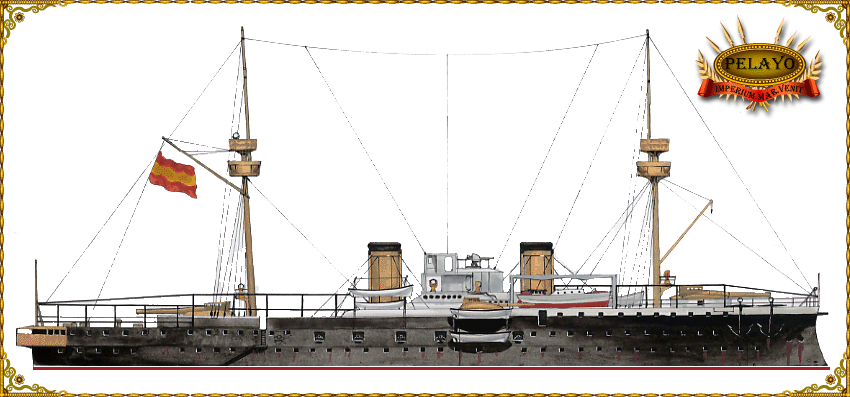


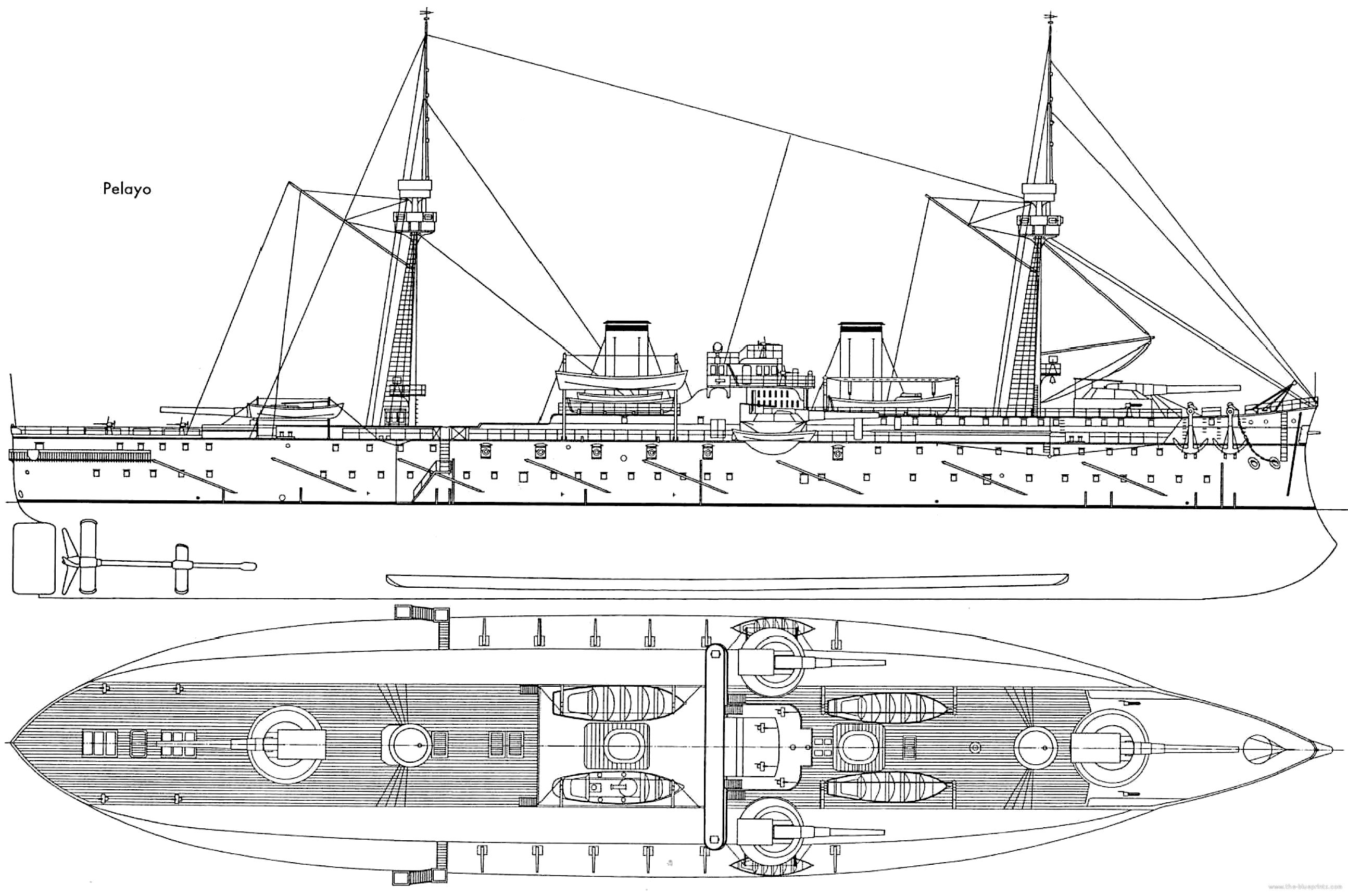
 Latest Facebook Entry -
Latest Facebook Entry -  X(Tweeter) Naval Encyclopedia's deck archive
X(Tweeter) Naval Encyclopedia's deck archive Instagram (@navalencyc)
Instagram (@navalencyc)





 French Navy
French Navy Royal Navy
Royal Navy Russian Navy
Russian Navy Armada Espanola
Armada Espanola Austrian Navy
Austrian Navy K.u.K. Kriegsmarine
K.u.K. Kriegsmarine Dansk Marine
Dansk Marine Nautiko Hellenon
Nautiko Hellenon Koninklije Marine 1870
Koninklije Marine 1870 Marinha do Brasil
Marinha do Brasil Osmanlı Donanması
Osmanlı Donanması Marina Do Peru
Marina Do Peru Marinha do Portugal
Marinha do Portugal Regia Marina 1870
Regia Marina 1870 Nihhon Kaigun 1870
Nihhon Kaigun 1870 Preußische Marine 1870
Preußische Marine 1870 Russkiy Flot 1870
Russkiy Flot 1870 Svenska marinen
Svenska marinen Søværnet
Søværnet Union Navy
Union Navy Confederate Navy
Confederate Navy Armada de Argentina
Armada de Argentina Imperial Chinese Navy
Imperial Chinese Navy Marinha do Portugal
Marinha do Portugal Mexico
Mexico Kaiserliche Marine
Kaiserliche Marine 1898 US Navy
1898 US Navy Sovietskiy Flot
Sovietskiy Flot Royal Canadian Navy
Royal Canadian Navy Royal Australian Navy
Royal Australian Navy RNZN Fleet
RNZN Fleet Chinese Navy 1937
Chinese Navy 1937 Kriegsmarine
Kriegsmarine Chilean Navy
Chilean Navy Danish Navy
Danish Navy Finnish Navy
Finnish Navy Hellenic Navy
Hellenic Navy Polish Navy
Polish Navy Romanian Navy
Romanian Navy Turkish Navy
Turkish Navy Royal Yugoslav Navy
Royal Yugoslav Navy Royal Thai Navy
Royal Thai Navy Minor Navies
Minor Navies Albania
Albania Austria
Austria Belgium
Belgium Columbia
Columbia Costa Rica
Costa Rica Cuba
Cuba Czechoslovakia
Czechoslovakia Dominican Republic
Dominican Republic Haiti
Haiti Hungary
Hungary Honduras
Honduras Estonia
Estonia Iceland
Iceland Eire
Eire Equador
Equador Iran
Iran Iraq
Iraq Latvia
Latvia Liberia
Liberia Lithuania
Lithuania Mandchukuo
Mandchukuo Morocco
Morocco Nicaragua
Nicaragua Persia
Persia San Salvador
San Salvador Sarawak
Sarawak Uruguay
Uruguay Venezuela
Venezuela Zanzibar
Zanzibar Warsaw Pact Navies
Warsaw Pact Navies Bulgaria
Bulgaria Hungary
Hungary

 Bundesmarine
Bundesmarine Dutch Navy
Dutch Navy Hellenic Navy
Hellenic Navy Marina Militare
Marina Militare Yugoslav Navy
Yugoslav Navy Chinese Navy
Chinese Navy Indian Navy
Indian Navy Indonesian Navy
Indonesian Navy JMSDF
JMSDF North Korean Navy
North Korean Navy Pakistani Navy
Pakistani Navy Philippines Navy
Philippines Navy ROKN
ROKN Rep. of Singapore Navy
Rep. of Singapore Navy Taiwanese Navy
Taiwanese Navy IDF Navy
IDF Navy Saudi Navy
Saudi Navy Royal New Zealand Navy
Royal New Zealand Navy Egyptian Navy
Egyptian Navy South African Navy
South African Navy






























 Ukrainian Navy
Ukrainian Navy dbodesign
dbodesign
My great great grandfather was a captain of the Pelayo .. his name was Enrique Perez Izquierdo.. he passed away in 1917 and laid in state on his ship .. I don’t see any mention of him here but I do have a picture of him on his ship
Hi Pamela, many thanks, feel to send this photo via [email protected]. I’ll integrate it into the article with a legend and courtesy credits.
David